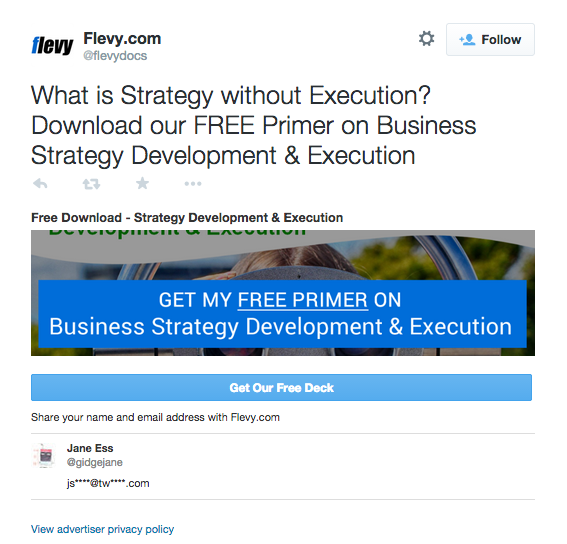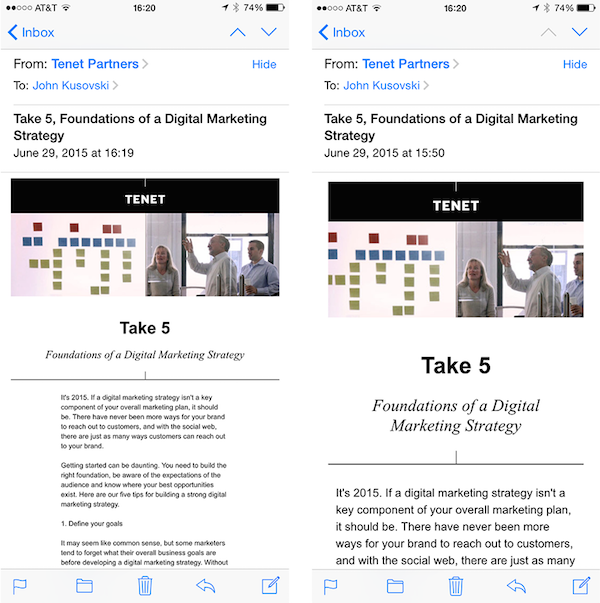In digital marketing — a space now overwhelmed by sexy social networks and innovative ad tech — there’s a misconception that email marketing is a thing of the past. However, despite the rise of other avenues of digital communication, email marketing is far from dead. In fact, according to a 2013 study by the Direct Marketing Association, email marketing provides an average return on investment of 4,300%, making it a direct digital marketing tool that is second-to-none.
But not all marketers are using email in the most effective way. Some have been slow to keep up with how it’s evolved with the technology we use today. Others, due to time constraints or the hope that newer channels would displace email, never executed their email marketing properly in the first place.
As in everything in life, there’s a right way and a wrong way to approach email marketing.
1. Build an audience, open to hearing your story
A successful email marketing campaign requires a captivated audience. If you’re starting from scratch, or your subscriber base is low, there are a multitude of strategies you can employ to build your email lists.
Popular amongst them all is the “give to get” approach. You give out a little bit of your knowledge and you get the right to court your potential audience. In B2B, this normally means sharing your thought leadership in exchange for people opting in to regular email communications. For B2C, marketers have found great success at list building through contests and product giveaways.

Social networks have also rolled out tools designed to opt-in users directly from their social timelines. Combined with a paid social media campaign, marketers can take advantage of soliciting opt-ins from targeted demographics.
Finally, employ a double opt-in procedure for your email signups. By asking a new subscriber to confirm permission to add them to your list, you receive verification that the email address provided wasn’t fake, and that your new recipient will be engaged.
2. Keep that ever-burgeoning database under control
Deploying email campaigns to poor quality lists can bring on very negative consequences — anywhere from being banned by ISPs to legal issues. Proper, routine maintenance on your email lists isn’t just optional — it’s required.
Begin by asking yourself some elementary questions: How did you build those lists? When did you last use them? Do you have permission to email the folks who found their way unto your list? For some jurisdictions and regulated industries, it’s a legal requirement to maintain information on the time, date and sign-up method for each recipient on your list. Bear in mind that when you do have permission, it goes stale after a period — generally six months to a year depending on deployment frequency. Performance metrics can signal if a recipient is no longer interested in receiving your emails.
But before you repeatedly hit the “Delete” button, there are alternatives for you to consider. A solid maintenance tactic to use on questionable records is to compile them into a one-off email campaign. Then, very simply, ask these contacts if they are still interested in hearing from you periodically. This respectful outreach gives you confirmation that you still have a live audience, as well as an opportunity for renewed engagement and sustained valuable communications.
3. Encourage feedback
Marketers too often neglect to provide a clear, direct way for your recipients to deliver feedback. An odd oversight when you think that this feedback mechanism is built into your email already — the reply button. When marketers send messages with a no-reply address, they unknowingly build a barrier between themselves and their audiences who have no direct avenue of communication. This misstep could cost you the goodwill of your audience, making your email vulnerable to spam filters. Ultimately, this could hurt the image of your brand as one that merely talks to customers, rather than engaging them in a dialogue.
If you don’t already have a reply-to email address set up, create one and make sure you’re set up for a proper monitoring. For example, at Tenet Partners, we send our newsletters from a dedicated email account, diligently monitored by our marketing team. It’s integrated in our customer service ecosystem, enabling us to quickly respond to requests for more information or unsubscribes, as well as complaints.
4. Develop your email messages for mobile
According to email testing and tracking service Litmus, a whopping 53% of all emails were opened on a mobile device in 2014. That is a 500% increase since 2011. Without taking measures to adjust your emails for mobile, you’re not giving due consideration to a large part of your audience.
But how do you adjust emails reliably for smaller screens? The solution is responsive email design.
Just as the web affords mobile users with experiences designed for smaller screens, email has the same potential — using the exact same code. Take a look at how Tenet’s Take 5 email transforms from a desktop to a mobile experience.

Some great effects can be achieved with responsive design, including but not limited to:
- Replacing images with mobile-friendly versions, rather than proportionally scaling down desktop images.
- Font sizes can be increased to adjust to a smaller screen.
- Entire blocks of content or superfluous images can be removed.
- Multi-column templates can shift to a single-column layout that flows on a vertical viewport
Another consideration for mobile — build your calls-to-action to account for tactile responses. Your recipient is going to use their fingers to navigate your email rather than a mouse, so craft calls-to-action large enough to be tapped on by a human finger. And don’t make people guess. Someone using a smartphone lacks cursor hover states to fall back on for hints on what is clickable and what is not. Try to avoid vague image-based calls-to-action and stick to text-based links and buttons.
5. Be respectful of your subscriber’s inbox
We all know how painful a stream of unsolicited messages can be. Make sure your recipients don’t see you as yet another spam email.
You can avoid this by respecting why your subscriber signed up to receive email marketing from you for a particular reason. If you give them what they want, you will create the foundation for a positive sender-recipient relationship. Don’t send along material that you believe your recipients might find interesting, even if it’s tangentially linked in some way to what you know they’ll find interesting.
Another way to demonstrate respect for your target audience is the right cadence for communication. When is it too much and when is it not enough? When intervals between touch points are too short, the annoying factor might go way up. On the other hand, prolonged absences might cause subscribers to forget about you and wonder whether they signed up for your emails in the first place. Take a close look at your email reports and analyze your engagement numbers. Low open rates are an indicator of fatigue, while high unsubscribes or spam complaints may mean you’ve taken too long to reach out.
6. Segment your lists and implement marketing automation
Another list management tactic is to divide your lists based on the recipient data you’ve collected. This process — commonly referred to as segmentation — recognizes the diversity of your audience and affords you the opportunity to deliver tailored messages that speak to the needs and desires of a subset group. For example, a financial services company could create a data segment using information on company size. That could lay the foundation for an email campaign that offers small business loan information to organizations with less than 50 employees.
Segmentation also pairs wonderfully with another advanced digital marketing tool — marketing automation. What marketing automation can do is help you identify what phase of your sales cycle a potential sales lead is in, and then automatically deliver an email marketing campaign to move the sales process forward. A popular B2C example is shopping cart abandonment, where users who fill their online shopping carts without completing a transaction are encouraged to do so with a reminder email — one that usually contains a coupon or discount code to make that push ever stronger.
For B2B communication, sales leads that express interest in your products or services on an initial sales call can be funneled into a drip email marketing campaign, one that monitors and adjusts for the behavior of your lead over time. Done properly, these emails can look as though they’re being sent from a sales representative, when in actuality they’re deployed from your marketing automation software — an ideal solution for large sales forces.
When what is old becomes new again
While email is one of the oldest forms of digital communication we have, age doesn’t equate to obsolescence. It’s a medium that has evolved, as text based emails have given way to HTML layouts that adjust to multiple viewports. And while social networks and messaging apps are growing in popularity, they still represent a fraction of the audience you can potentially reach. If your goal is to build a foundation for your digital marketing, email marketing represents a lucrative engagement opportunity that marketers should never pass up.
